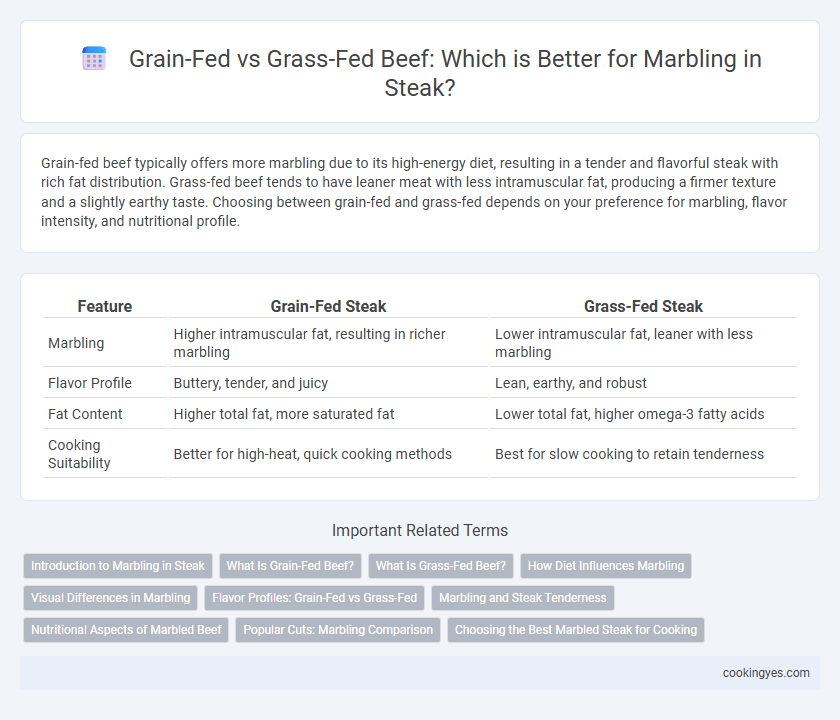Grain-fed beef typically offers more marbling due to its high-energy diet, resulting in a tender and flavorful steak with rich fat distribution. Grass-fed beef tends to have leaner meat with less intramuscular fat, producing a firmer texture and a slightly earthy taste. Choosing between grain-fed and grass-fed depends on your preference for marbling, flavor intensity, and nutritional profile.
Table of Comparison
| Feature | Grain-Fed Steak | Grass-Fed Steak |
|---|---|---|
| Marbling | Higher intramuscular fat, resulting in richer marbling | Lower intramuscular fat, leaner with less marbling |
| Flavor Profile | Buttery, tender, and juicy | Lean, earthy, and robust |
| Fat Content | Higher total fat, more saturated fat | Lower total fat, higher omega-3 fatty acids |
| Cooking Suitability | Better for high-heat, quick cooking methods | Best for slow cooking to retain tenderness |
Introduction to Marbling in Steak
Marbling in steak refers to the intramuscular fat dispersed within the meat fibers, significantly impacting flavor, tenderness, and juiciness. Grain-fed beef tends to have higher marbling due to a calorie-rich diet that promotes fat deposition, resulting in a more buttery texture. Grass-fed beef usually offers leaner meat with less marbling but contains distinct flavor profiles influenced by pasture nutrients.
What Is Grain-Fed Beef?
Grain-fed beef comes from cattle that are primarily fed a diet of corn, barley, or other grains during the final stages of their growth, leading to higher marbling and a richer, buttery flavor. This diet increases intramuscular fat, resulting in more tender and juicier steaks compared to grass-fed beef. Grain-fed beef is often preferred for its consistent texture and enhanced taste profile in premium cuts.
What Is Grass-Fed Beef?
Grass-fed beef comes from cattle raised primarily on natural forage, resulting in leaner meat with distinct marbling patterns compared to grain-fed beef. The marbling in grass-fed beef tends to be less dense but offers a richer flavor profile due to higher omega-3 fatty acids and antioxidants. This type of beef is often sought for its natural diet and health benefits, influencing both texture and nutrient composition in steaks.
How Diet Influences Marbling
Diet plays a crucial role in the marbling of steak, with grain-fed cattle typically exhibiting higher intramuscular fat due to their energy-dense feed. Grain-fed diets rich in corn and other grains promote faster weight gain and greater fat deposition within muscle fibers, resulting in more pronounced marbling. In contrast, grass-fed beef tends to have leaner meat with less marbling, as the forage-based diet is lower in calories and influences fat distribution differently.
Visual Differences in Marbling
Grain-fed steaks exhibit more abundant and finely distributed marbling with a creamy white appearance, creating a consistent pattern that enhances tenderness and flavor. Grass-fed steaks often display less marbling with a coarser, more uneven texture and a slightly yellowish hue due to higher beta-carotene content. These visual differences make grain-fed beef more visually appealing for marbling-focused consumers seeking richer taste profiles.
Flavor Profiles: Grain-Fed vs Grass-Fed
Grain-fed steak typically features higher marbling, resulting in a rich, buttery flavor and tender texture due to the increased intramuscular fat. Grass-fed steak offers a leaner profile with a more pronounced, earthy, and robust taste, often described as grassy or gamey, reflecting the natural diet. The difference in flavor profiles stems from the distinct fatty acid composition influenced by the animal's diet, impacting both taste and juiciness.
Marbling and Steak Tenderness
Marbling plays a crucial role in steak tenderness, with grain-fed beef typically exhibiting higher intramuscular fat compared to grass-fed beef. This increased marbling in grain-fed steaks enhances juiciness and creates a more tender eating experience due to the fat melting during cooking. Grass-fed beef, while leaner, often results in firmer texture and less marbled flavor profiles.
Nutritional Aspects of Marbled Beef
Grain-fed beef typically exhibits higher marbling due to a diet rich in energy-dense grains, which enhances intramuscular fat content and improves tenderness and flavor. Grass-fed beef offers a leaner profile with lower overall fat, but contains higher levels of omega-3 fatty acids, conjugated linoleic acid, and antioxidants like vitamin E. Marbled beef from grain-fed cattle provides increased monounsaturated fats, contributing to better palatability while grass-fed options emphasize beneficial nutrient density and a healthier lipid profile.
Popular Cuts: Marbling Comparison
Grain-fed steaks typically exhibit higher marbling levels, especially in popular cuts like ribeye and New York strip, resulting in richer flavor and tender texture. Grass-fed beef often has leaner cuts such as sirloin and flank steak, with less intramuscular fat but a more robust, earthy taste. Marbling intensity directly impacts juiciness and mouthfeel, making grain-fed options favored for buttery consistency in premium steaks.
Choosing the Best Marbled Steak for Cooking
Grain-fed steaks typically exhibit higher marbling due to the energy-dense diet, resulting in richer flavor and tenderness favored for grilling and frying. Grass-fed steaks contain less intramuscular fat but offer a leaner, more robust taste profile ideal for those seeking a healthier, more natural option. Selecting the best marbled steak depends on cooking methods and personal preference, with grain-fed preferred for buttery texture and grass-fed for a firmer bite and distinct flavor complexity.
Grain-fed vs Grass-fed for Marbling Infographic

 cookingyes.com
cookingyes.com